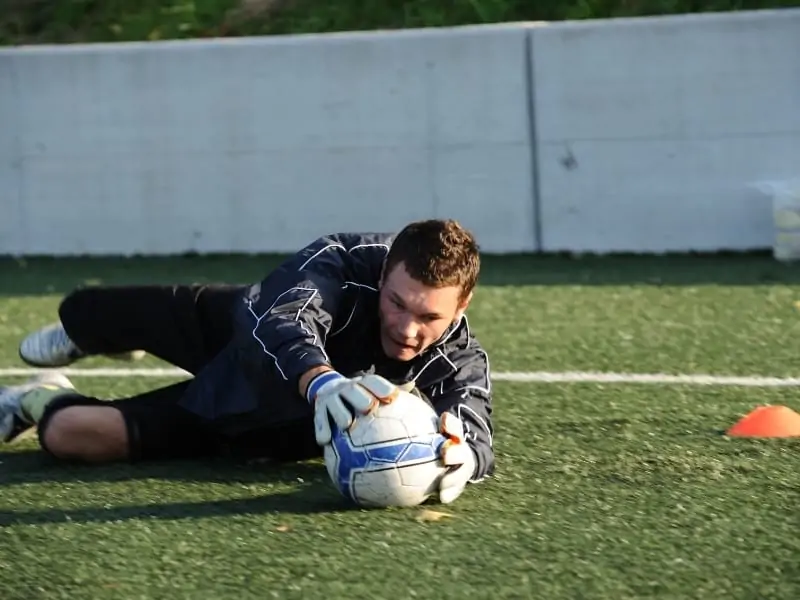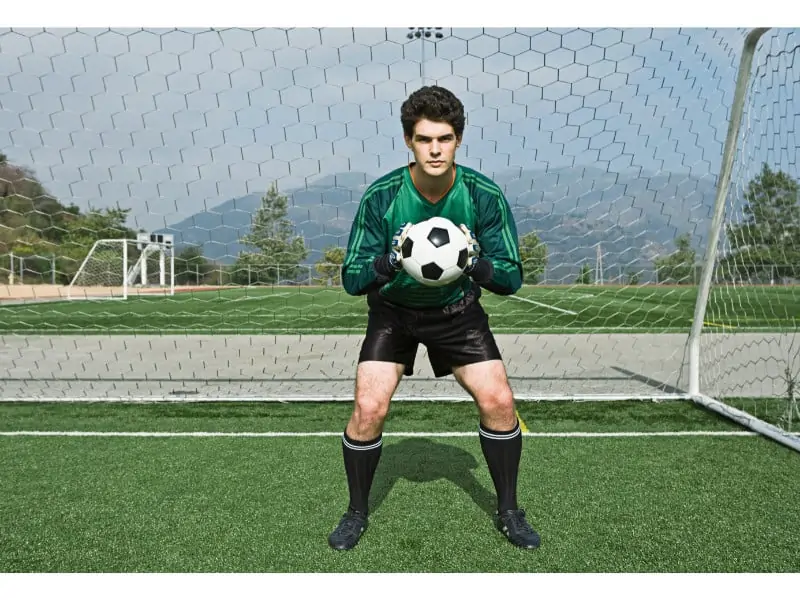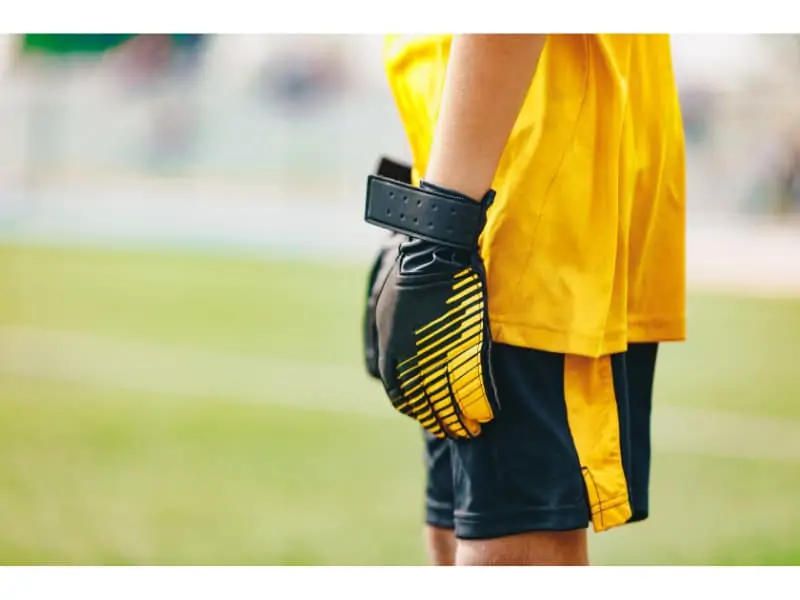Share the post "Do Soccer Goalies Wear Cups? (Essential Protection)"
I play a variety of ball sports, and one thing is for sure, there have been a few days that I wished I had worn a cup before playing.
In my years as an amateur soccer player, I can’t recall ever seeing a cup being used by any goalie or player, for that matter. So, why don’t soccer goalies wear cups, and what are the possible dangers of not wearing one?
- Soccer goalies need to perform a wide variety of body movements, and cups may hinder this movement.
- What protective equipment do soccer associations make goalies wear?
- FIFA has no rule that hinders a goalie from wearing a cup
- The dangers of getting kicked in the groin area
- Most common goalie injuries
If you aspire to be a goalie and are still relatively young, wearing a cup could be the right option until you gain some experience behind the sticks.
In this article, we will discuss why goalies don’t wear cups, what the law states regarding goalie kits, what you should have in your kit, and the most common goalie injuries.

Why Don’t Soccer Goalies Wear Cups?
Wearing a cup will affect a goalie’s movement negatively, as a cup restricts the body movements that a goalie needs to perform when tending the goal area.
It also hinders the natural mechanics when kicking a ball. Landing on a cup when diving around can just be as bad as a kick to the groin.
Soccer goalies are usually some of the toughest players on the pitch. They have to be, as their primary job is being the last line of defense for their team, making sure that they keep the other team from scoring.
Soccer goalies can use their hands, feet, legs, upper body, and even their heads to keep the ball from crossing the line.
Movement
Goalies need to be very agile and able to change direction instantly, moving toward the oncoming attacking player when the situation requires (putting their bodies on the line), and “fly” through the air to palm away strikes.
Landing on a cup when falling from a distance of 8-feet (the height of a goal post) could feel as if someone just kicked you in the groin.
Wearing a cup will interfere with the mechanics of kicking a ball.
The cup will feel uncomfortable and could detract from the distance of a goalie’s clearance kick. The restrictions that wearing a cup will impose on the wearer outweigh the safety level it offers in return.
After reading the above, you might assume that a cup should be the first object a soccer goalie puts on when kitting up for a game. Yet, the opposite is true; most professional goalies, and amateurs for that matter, do not wear a cup.
Performance
Wearing a cup might protect the groin area but will affect the goalie’s performance and movement negatively.
The primary reason is that wearing a cup, no matter how well it’s designed, will impede a soccer goalie’s natural movement and may even cause injury to the nether regions when falling awkwardly and performing expected duties.
Goalies do wear protection in other areas where they are known to pick up injuries, like elbows, wrists, and so forth. I will discuss some of these items later.

An essential factor to consider why cups are deemed unnecessary is we are mainly referring to professional athletes who train in such a way to minimize injuries and also negate potentially dangerous situations by using the correct body positions when required.
Soccer Laws Regarding Wearing A Cup?
There is no law that states that a goalie must wear a cup. Such a law does not exist. It seems that every soccer goalie can make up their mind when it comes to wearing a cup.
According to the new FIFA Rulebook for 2021 states on page 56 regarding players equipment, that goalies wear:
- Shirts with sleeves
- Shorts
- Socks
- Shin guards
- Footwear
- Tracksuit bottoms
- Gloves
And to quote them directly:
”Non-dangerous protective equipment, for example, headgear, facemasks, knee and arm protectors made of soft, lightweight padded material is permitted as are goalkeepers’ caps and sports spectacles.”
FIFA Rulebook – 2021
If goalies were constantly being hit in the baby-making region, FIFA and other soccer associations would have incorporated wearing a cup into their rules and regulations.
As with any sport involving balls, there is an outside chance that you will get hit in uncomfortable areas. However, in soccer, the probability of this happening frequently is so low that the rules reflect this.
What Items Should A Typical Goalie Kit Contain?
A typical goalie kit does not contain a cup; instead, it includes various items that protect the body’s parts that typically take the most strain and need protection in every game. Let us look at the item’s that all goalies should have in their kits:
- Shin guards
- True socks
- Elbow protectors
- Firm-ground soccer boots
- Knee pads (optional)
- Soft ground soccer boots
- Glove glue
- Glove wash
- Towel
- Padded jersey and shorts
- Wrist tape
- Extra boot laces
- Full length padded goalie pants
- Goalie pants
- Gloves

As you may have rightly noticed, there is no mention of a cup, and Amazon only advertises youth slider shorts that have a built-in place for a cup, but the cup is not included in the sale.
There is no market for soccer cups that should indicate that soccer players don’t wear cups.
What Are The Dangers Of Not Using A Cup?
I have been hit in the testicles a few times when playing ball sports. To say it was uncomfortable would be taking away the immense pain experienced in these moments.
Ask any man to describe the experience, and you will encounter a flinch before hearing the answer. Pain wise it should rank up there with labor pains, I would think.
Even when I wore a cup for protection, being hit by a hardball traveling at tremendous speeds stays painful and an absolute shock to the system.
Why is it such an awful experience, and what are the dangers of taking a hit in the testicles?
Why Not Wearing A Cup Should Make You Nervous?
The answer is pretty obvious: No man wants to be hit in the groin! Men’s Health interviewed Dr. Jamin Brahmbhatt (co-director of the PUR Clinic in Orlando), who specializes in urology and men’s health, in 2017.
He mentioned that a man’s groin area is such a sensitive area because the scrotum and testes are pretty much a bundle of nerves.
Any nerve pain experienced by a blow in this sensitive region will radiate to other parts of the body.
Taking a hit in the ball area usually leads to massive pain in the stomach area, which can often lead to nausea and, worst-case scenario, vomiting.
He explained that men’s testicles begin their development journey near the kidneys, establishing a nerve that makes its way from the abdomen to the scrotum.
Nerve pain does not stay put in one area. The pain radiates to other parts of the body because of all the nerve connections.
The Dangers Of Taking A Direct Hit To Your Testicles
Dr. Brahmbhatt explains that such an episode is usually short-lived, even though it could feel like centuries of pain at the time.
The pain should subside within 15 minutes. If you are not feeling better after this time frame and still on the floor crying, you need to get to the ER as fast as possible.
Prolonged pain can be a sign of the following:
- A ruptured testicle may prompt internal bleeding.
- Loss of blood supply to a testicle can end up in you losing one of your little friends.
- Trauma could extend to the penis that can cause pain and swell there.
If the pain does not subside after 15 minutes, you should race to the ER as it could lead to the loss of a testicle, which will, in turn, affect your:
- Fertility
- Testosterone levels
- Sexual function in some cases
As you can see, wearing a cup in sports that require them is very important. I have found that the smaller balls (baseballs, cricket balls, and even tennis balls) have caused me much more pain than getting hit by bigger balls (basketball, soccer ball, or even a volleyball).
That is just my experience when it comes to being hit in the balls by a ball.
Most Common Injuries Involving Soccer Goalies
If you have never watched or played soccer yourself, you could be thinking that goalies will be injured in the areas that they are least protected, like in the groin area.
You would be wrong to assume that as the following injuries are what most soccer goalies suffer from at some time during their careers:
- Shoulder
- Forearm
- Elbow
- Wrist
- Hand
- Fingers
As is life, some goalies have been kicked in the groin. It’s pretty rare but will happen occasionally.
References
- Goalkeepers Get Injured Too! – SoccerNation
- Soccer Equipment List | FIFA Football Gear and Clothing (theukrules.co.uk)
- Do Soccer Players Wear Cups And Would It Even Help? (the18.com)
Share the post "Do Soccer Goalies Wear Cups? (Essential Protection)"
Joel is a seasoned soccer journalist and analyst with many years of experience in the field. Joel specializes in game analysis, player profiles, transfer news, and has a keen eye for the tactical nuances of the game. He played at various levels in the game and coached teams - he is happy to share his insight with you.



